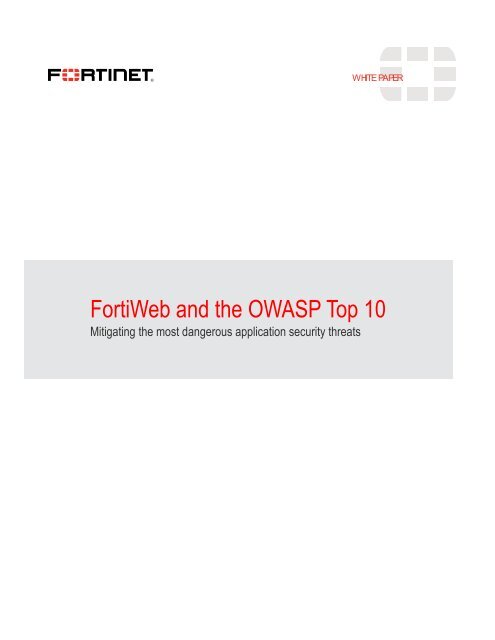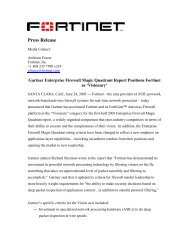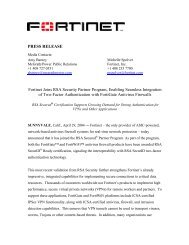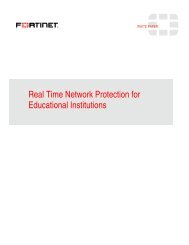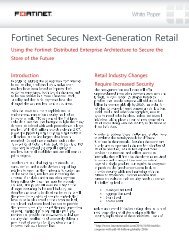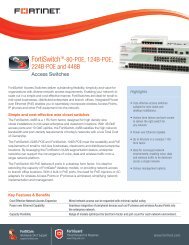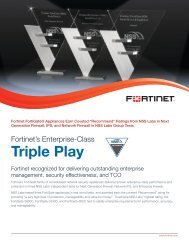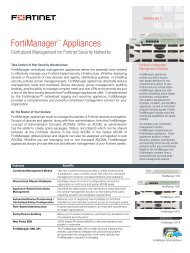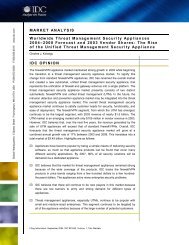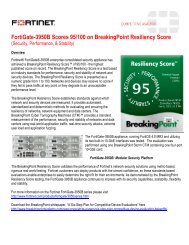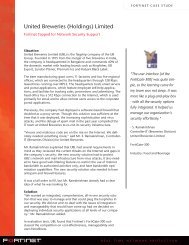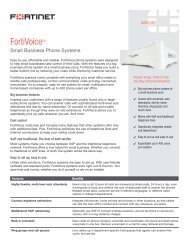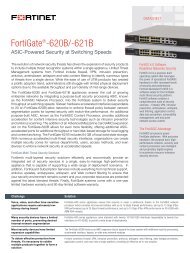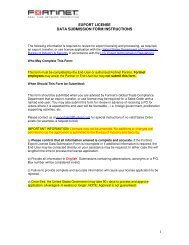FortiWeb and the OWASP Top 10 - Fortinet
FortiWeb and the OWASP Top 10 - Fortinet
FortiWeb and the OWASP Top 10 - Fortinet
You also want an ePaper? Increase the reach of your titles
YUMPU automatically turns print PDFs into web optimized ePapers that Google loves.
WHITEPAPER<br />
<strong>FortiWeb</strong> <strong>and</strong> <strong>the</strong> <strong>OWASP</strong> <strong>Top</strong> <strong>10</strong><br />
Mitigating <strong>the</strong> most dangerous application security threats
FORTINET – <strong>FortiWeb</strong> <strong>and</strong> <strong>the</strong> <strong>OWASP</strong> <strong>Top</strong> <strong>10</strong><br />
Mitigating <strong>the</strong> most dangerous application security threats<br />
Introduction<br />
The Open Web Application Security project (<strong>OWASP</strong>) <strong>Top</strong> Ten provides a powerful awareness document for web<br />
application security. The <strong>OWASP</strong> <strong>Top</strong> Ten represents a broad consensus about what <strong>the</strong> most critical web application<br />
security flaws are as identified by a variety of security experts from around <strong>the</strong> world who have shared <strong>the</strong>ir expertise to<br />
produce this list.<br />
The U.S. Federal Trade Commission strongly recommends that all companies use <strong>the</strong> <strong>OWASP</strong> <strong>Top</strong> Ten <strong>and</strong> ensure that<br />
<strong>the</strong>ir partners do <strong>the</strong> same. In addition, <strong>the</strong> U.S. Defense Information Systems Agency has listed <strong>the</strong> <strong>OWASP</strong> <strong>Top</strong> Ten<br />
as key for best practices.<br />
In <strong>the</strong> commercial market, <strong>the</strong> Payment Card Industry (PCI) st<strong>and</strong>ard has adopted <strong>the</strong> <strong>OWASP</strong> <strong>Top</strong> Ten <strong>and</strong> lists it as a<br />
key requirement as part of section 6 – “Develop <strong>and</strong> maintain secure systems <strong>and</strong> applications” m<strong>and</strong>ating that all web<br />
applications be developed according to security guidelines to protect against <strong>the</strong> <strong>OWASP</strong> <strong>Top</strong> <strong>10</strong>.<br />
Web Application Security Challenges<br />
Web applications are attractive targets to hackers as often <strong>the</strong>y are public facing applications that are required to be open to <strong>the</strong> internet<br />
as <strong>the</strong>y provide major e-commerce <strong>and</strong> business driving tools for organizations. Connected to backend databases web applications are<br />
perfect for hackers as <strong>the</strong>se databases are <strong>the</strong> primary repository for card holder data, company data <strong>and</strong> o<strong>the</strong>r sensitive information.<br />
According to <strong>the</strong> SANS attacks against web applications constitute more than 60% of <strong>the</strong> total attack attempts observed on <strong>the</strong> Internet.<br />
Web application vulnerabilities such as SQL injection <strong>and</strong> Cross-Site Scripting flaws in custom-built applications account for more than<br />
80% of <strong>the</strong> vulnerabilities being discovered.<br />
The difficulty in protecting web applications is <strong>the</strong>ir architecture <strong>and</strong> dynamics. While network security is simple – define security policies<br />
to allow/block specific traffic to <strong>and</strong> from different networks/servers, applications consist of hundreds <strong>and</strong> sometimes thous<strong>and</strong>s of<br />
different elements- URLs, parameters <strong>and</strong> cookies.<br />
Manually creating different policies for each of <strong>the</strong>se items is almost impossible <strong>and</strong> obviously does not scale. On top of this, web<br />
applications change frequently with new URLs <strong>and</strong> parameters being added making it difficult for security administrators to update <strong>the</strong>ir<br />
security policies.<br />
<strong>FortiWeb</strong> Web Application Firewall<br />
Combining both Web Application Firewall <strong>and</strong> XML Firewall capabilities in a single platform <strong>the</strong> <strong>FortiWeb</strong> solution allows<br />
enterprises to protect against application level attacks targeted at <strong>the</strong> Web application <strong>and</strong> web services infrastructure.<br />
Using advanced techniques to provide against SQL injection, Cross site scripting <strong>and</strong> a range of o<strong>the</strong>r attacks helps to<br />
prevent identity <strong>the</strong>ft, financial fraud <strong>and</strong> corporate espionage which can result in significant damage.<br />
<strong>FortiWeb</strong> provides flexible <strong>and</strong> reliable protection to address <strong>the</strong> <strong>OWASP</strong> <strong>Top</strong> Ten by utilizing a range of in-depth<br />
security modules <strong>and</strong> technologies. Sophisticated attacks are blocked using a multi layered security approach.<br />
Incorporating a positive <strong>and</strong> a negative security module based on bi-directional traffic analysis <strong>and</strong> an embedded<br />
behavioral based anomaly detection engine <strong>FortiWeb</strong> can protect against a broad range of threats without <strong>the</strong> need for<br />
network re-architecture <strong>and</strong> application changes.<br />
<strong>FortiWeb</strong> Incorporates two security models in order to protect both known <strong>and</strong> unknown vulnerabilities:<br />
Positive Security Model<br />
<strong>FortiWeb</strong> uses Positive Security Model to protect against any known <strong>and</strong> especially unknown vulnerabilities. Once a new<br />
web application policy is defined, <strong>FortiWeb</strong> starts monitoring traffic flowing to <strong>the</strong> application <strong>and</strong> based on a behavioral<br />
analysis technology called Auto-Learn <strong>FortiWeb</strong> builds a dynamic baseline of allowed elements for <strong>the</strong> application. By<br />
analyzing user behavior <strong>FortiWeb</strong> underst<strong>and</strong>s how <strong>the</strong> web application should be accessed. Authorized URLs are<br />
created with <strong>the</strong> relevant parameters for each of <strong>the</strong> URLs. Parameters constraint characteristics are profiled as well to<br />
provide an overall picture of <strong>the</strong> web application structure <strong>and</strong> what constitutes as normal user behavior.<br />
PAGE 2
FORTINET – <strong>FortiWeb</strong> <strong>and</strong> <strong>the</strong> <strong>OWASP</strong> <strong>Top</strong> <strong>10</strong><br />
Mitigating <strong>the</strong> most dangerous application security threats<br />
Using a sophisticated engine <strong>FortiWeb</strong> only adds normal behavior to <strong>the</strong> profile making sure any abnormal activity is<br />
discarded.<br />
The Auto-Learn profiling capability is completely transparent <strong>and</strong> does not require any changes to <strong>the</strong> application or<br />
network architecture. <strong>FortiWeb</strong> does not scan <strong>the</strong> application in order to build <strong>the</strong> profile, but ra<strong>the</strong>r analyzes <strong>the</strong> traffic<br />
as it monitors it flowing to <strong>the</strong> application.<br />
By creating a comprehensive security model of <strong>the</strong> application <strong>FortiWeb</strong> can now protect against any known or unknown<br />
vulnerabilities, zero day attacks such as SQL Injection, Cross Site Scripting, <strong>and</strong> o<strong>the</strong>r application layer attacks.<br />
Negative Security Model<br />
Figure 1 <strong>and</strong> 2 <strong>FortiWeb</strong> Traffic Analysis based on Positive Security Model<br />
<strong>FortiWeb</strong> includes a full application signature dictionary to protect against known application layer attacks. A<br />
sophisticated engine scans both inbound <strong>and</strong> outbound traffic, matching elements with pre-defined known exploits.<br />
A comprehensive flexible engine also allows customers to write <strong>the</strong>ir own signatures using a sophisticated regular<br />
expression engine which provides <strong>the</strong> ability to create new <strong>and</strong> customized signatures for every application <strong>and</strong><br />
vulnerability.<br />
<strong>FortiWeb</strong>’s signature dictionary is updated regularly <strong>and</strong> automatically via FortiGuard, a Security Subscription Service<br />
which delivers continuous, automated updates <strong>and</strong> offers dynamic protection based on <strong>the</strong> work of <strong>the</strong> <strong>Fortinet</strong>® Global<br />
Security Research Team, which researches <strong>and</strong> develops protection against known <strong>and</strong> potential security threats.<br />
The negative security layer is extended with an HTTP RFC enforcement layer making sure any access to <strong>the</strong> protected<br />
application is done according to <strong>the</strong> HTTP st<strong>and</strong>ard. <strong>FortiWeb</strong> provides an enhanced policy configuration with multiple<br />
rules to protect against buffer overflows, encoding based attacks <strong>and</strong> any o<strong>the</strong>r attack that tries to manipulate <strong>the</strong> HTTP<br />
protocol.<br />
PAGE 3
FORTINET – <strong>FortiWeb</strong> <strong>and</strong> <strong>the</strong> <strong>OWASP</strong> <strong>Top</strong> <strong>10</strong><br />
Mitigating <strong>the</strong> most dangerous application security threats<br />
Figure 3 <strong>and</strong> 4 <strong>FortiWeb</strong> Robot Control <strong>and</strong> Common Exploits are part of <strong>the</strong> Negative Security Model<br />
Additional <strong>FortiWeb</strong> Functionality Helps Protect against <strong>OWASP</strong> <strong>Top</strong> <strong>10</strong><br />
Data Leak Prevention <strong>and</strong> Information Disclosure<br />
<strong>FortiWeb</strong> extends monitoring <strong>and</strong> protection to outgoing traffic such as credit card leakage <strong>and</strong> information disclosure.<br />
Providing multiple policies for information disclosure <strong>FortiWeb</strong> immediately alerts any web application abnormalities that<br />
may be caused by an attack or by poor application configuration. Rules can be extended to rewrite information<br />
disclosure such that users are not exposed to any sensitive application data. Additional credit card leakage rules make<br />
sure any outgoing traffic does not include credit card numbers.<br />
<strong>FortiWeb</strong> also allows customers to create <strong>the</strong>ir own custom rules providing an entire solution for Data Leak Prevention.<br />
Web Vulnerability Scanner<br />
Figure 5 <strong>FortiWeb</strong> Protects against Information Disclosure<br />
PAGE 4<br />
<strong>FortiWeb</strong> is <strong>the</strong> only vendor that provides a Vulnerability Scanner module within <strong>the</strong> web application firewall that automatically scans <strong>and</strong><br />
analyzes <strong>the</strong> protected web applications <strong>and</strong> detects security weaknesses, known <strong>and</strong> unknown vulnerabilities.<br />
Toge<strong>the</strong>r with <strong>the</strong> web application firewall <strong>FortiWeb</strong> completes a comprehensive solution for PCI DSS requirement 6.6 <strong>and</strong> 6.5 allowing<br />
organizations to scan <strong>the</strong>ir applications, identify vulnerabilities <strong>and</strong> protect <strong>the</strong>m in real time from <strong>the</strong> same platform.
FORTINET – <strong>FortiWeb</strong> <strong>and</strong> <strong>the</strong> <strong>OWASP</strong> <strong>Top</strong> <strong>10</strong><br />
Mitigating <strong>the</strong> most dangerous application security threats<br />
Figure 6 <strong>FortiWeb</strong>’s Vulnerability Scanner<br />
Page Access <strong>and</strong> Start Page Enforcement<br />
Enforcing access to <strong>the</strong> application according to <strong>the</strong> correct business logic is an important part of web application<br />
security. Applications that do not enforce this open <strong>the</strong>mselves to Cross Site Request Forgery (CSRF) attacks. For<br />
example, e-commerce applications should not allow access to <strong>the</strong> shipping or payments stage directly, without prior<br />
access to <strong>the</strong> ordering pages.<br />
By defining a Page Access rule on <strong>FortiWeb</strong> CSRF attacks are immediately blocked helping with <strong>OWASP</strong> <strong>Top</strong> Ten A5<br />
requirement.<br />
Additionally, <strong>FortiWeb</strong> offers a Start Page policy as well which defines <strong>the</strong> entry point to <strong>the</strong> application helping with<br />
requests that try to circumvent au<strong>the</strong>ntication or any o<strong>the</strong>r environment that requires users to start browsing at a specific<br />
page.<br />
<strong>OWASP</strong> <strong>Top</strong> Ten <strong>and</strong> <strong>FortiWeb</strong> Mitigation Technique<br />
The table below lists <strong>the</strong> <strong>OWASP</strong> <strong>Top</strong> Ten <strong>and</strong> <strong>the</strong> corresponding <strong>FortiWeb</strong> mitigation techniques.<br />
A1. Injection<br />
<strong>OWASP</strong> <strong>Top</strong> <strong>10</strong> Explanation <strong>FortiWeb</strong> Mitigation<br />
A2. Cross-Site Scripting<br />
(XSS)<br />
Injection flaws, such as SQL, OS, <strong>and</strong> LDAP<br />
injection, occur when untrusted data is sent to<br />
an interpreter as part of a comm<strong>and</strong> or query.<br />
The attacker’s hostile data can trick <strong>the</strong><br />
interpreter into executing unintended<br />
comm<strong>and</strong>s or accessing unauthorized data.<br />
XSS flaws occur whenever an application takes<br />
untrusted data <strong>and</strong> sends it to a web browser<br />
without proper validation <strong>and</strong> escaping. XSS<br />
allows attackers to execute scripts in <strong>the</strong><br />
victim’s browser which can hijack user sessions,<br />
deface web sites, or redirect <strong>the</strong> user to<br />
malicious sites.<br />
PAGE 5<br />
Auto-Learn profiling automatically builds<br />
an allowed baseline allowing a<br />
comprehensive request validation<br />
feature to enforce strict URL <strong>and</strong><br />
parameter control. Enhanced application<br />
signature detection engine adds a<br />
secondary layer for abnormal characters<br />
<strong>and</strong> known injection strings.<br />
Application signature detection engine<br />
includes various XSS signatures. Request<br />
validation process ensures only relevant<br />
characters can be submitted.
FORTINET – <strong>FortiWeb</strong> <strong>and</strong> <strong>the</strong> <strong>OWASP</strong> <strong>Top</strong> <strong>10</strong><br />
Mitigating <strong>the</strong> most dangerous application security threats<br />
A3. Broken Au<strong>the</strong>ntication<br />
<strong>and</strong> Session Management<br />
A4. Insecure Direct Object<br />
References<br />
A5. Cross-Site Request<br />
Forgery (CSRF)<br />
A6. Security<br />
Misconfiguration<br />
A7. Insecure Cryptographic<br />
Storage<br />
Application functions related to au<strong>the</strong>ntication<br />
<strong>and</strong> session management are often not<br />
implemented correctly, allowing attackers to<br />
compromise passwords, keys, session tokens,<br />
or exploit o<strong>the</strong>r implementation flaws to<br />
assume o<strong>the</strong>r users’ identities.<br />
A direct object reference occurs when a<br />
developer exposes a reference to an internal<br />
implementation object, such as a file, directory,<br />
or database key. Without an access control<br />
check or o<strong>the</strong>r protection, attackers can<br />
manipulate <strong>the</strong>se references to access<br />
unauthorized data.<br />
A CSRF attack forces a logged-on victim’s<br />
browser to send a forged HTTP request,<br />
including <strong>the</strong> victim’s session cookie <strong>and</strong> any<br />
o<strong>the</strong>r automatically included au<strong>the</strong>ntication<br />
information, to a vulnerable web application.<br />
This allows <strong>the</strong> attacker to force <strong>the</strong> victim’s<br />
browser to generate requests <strong>the</strong> vulnerable<br />
application thinks are legitimate requests from<br />
<strong>the</strong> victim.<br />
Good security requires having a secure<br />
configuration defined <strong>and</strong> deployed for <strong>the</strong><br />
application, frameworks, application server,<br />
web server, database server, <strong>and</strong> platform. All<br />
<strong>the</strong>se settings should be defined, implemented,<br />
<strong>and</strong> maintained as many are not shipped with<br />
secure defaults. This includes keeping all<br />
software up to date, including all code libraries<br />
used by <strong>the</strong> application.<br />
Many web applications do not properly protect<br />
sensitive data, such as credit cards, SSNs, <strong>and</strong><br />
au<strong>the</strong>ntication credentials, with appropriate<br />
encryption or hashing. Attackers may steal or<br />
modify such weakly protected data to conduct<br />
identity <strong>the</strong>ft, credit card fraud, or o<strong>the</strong>r<br />
crimes.<br />
PAGE 6<br />
Enforces session management with strict<br />
cookie control. Provides various<br />
Au<strong>the</strong>ntication Offload capabilities<br />
(supporting Local, LDAP <strong>and</strong> NTLM) to<br />
minimize application security flaws.<br />
Auto-Learn profiling builds a<br />
comprehensive profile of allowed<br />
elements within <strong>the</strong> application. Any<br />
attempt to manipulate a parameter will<br />
trigger an alert <strong>and</strong> immediately be<br />
blocked.<br />
Hidden Fields Rules detect <strong>and</strong> block any<br />
attempt by <strong>the</strong> client to alter a hidden<br />
parameter value.<br />
Strict reference page enforcing provides<br />
protection against sophisticated CSRF<br />
attacks. Also, page access rules allow<br />
customers to define URL order. Common<br />
CSRF attacks attempt to submit a specific<br />
crafted request. For example, <strong>FortiWeb</strong><br />
enforces a page order sequence that will<br />
block <strong>the</strong> request if it didn’t go through<br />
<strong>the</strong> proper payment order sequence <strong>and</strong><br />
as such - invalid.<br />
1) Using Auto-Learn <strong>FortiWeb</strong> will block<br />
any attempt made by an attacker to<br />
exploit a misconfigured web application.<br />
2) Through monitoring application<br />
responses, <strong>FortiWeb</strong> is able to identify<br />
any application failure.<br />
3) Vulnerability Scanner module scans<br />
<strong>the</strong> protected applications, finds inherent<br />
misconfigurations <strong>and</strong> quickly turns <strong>the</strong>m<br />
to security rules.<br />
Extended monitoring <strong>and</strong> protection for<br />
all outgoing traffic prevents sensitive<br />
information leakage such as credit card<br />
numbers, Social Security numbers <strong>and</strong><br />
many o<strong>the</strong>r types of information<br />
disclosure.
FORTINET – <strong>FortiWeb</strong> <strong>and</strong> <strong>the</strong> <strong>OWASP</strong> <strong>Top</strong> <strong>10</strong><br />
Mitigating <strong>the</strong> most dangerous application security threats<br />
A8. Failure to Restrict URL<br />
Access<br />
A9. Insufficient Transport<br />
Layer Protection<br />
A<strong>10</strong>.Unvalidated Redirects<br />
<strong>and</strong> Forwards<br />
Summary<br />
Many web applications check URL access rights<br />
before rendering protected links <strong>and</strong> buttons.<br />
However, applications need to perform similar<br />
access control checks each time <strong>the</strong>se pages<br />
are accessed, or attackers will be able to forge<br />
URLs to access <strong>the</strong>se hidden pages anyway.<br />
Applications frequently fail to au<strong>the</strong>nticate,<br />
encrypt, <strong>and</strong> protect <strong>the</strong> confidentiality <strong>and</strong><br />
integrity of sensitive network traffic. When<br />
<strong>the</strong>y do, <strong>the</strong>y sometimes support weak<br />
algorithms, use expired or invalid certificates,<br />
or do not use <strong>the</strong>m correctly.<br />
Web applications frequently redirect <strong>and</strong><br />
forward users to o<strong>the</strong>r pages <strong>and</strong> websites, <strong>and</strong><br />
use untrusted data to determine <strong>the</strong><br />
destination pages. Without proper validation,<br />
attackers can redirect victims to phishing or<br />
malware sites, or use forwards to access<br />
unauthorized pages.<br />
PAGE 7<br />
Au<strong>the</strong>ntication Offload allows<br />
organizations to use <strong>FortiWeb</strong> to<br />
au<strong>the</strong>nticate different URLs in different<br />
Realms. Administrators can define URL<br />
groups that require specific<br />
au<strong>the</strong>ntication while o<strong>the</strong>r URLs open to<br />
<strong>the</strong> public. Using <strong>FortiWeb</strong>’s<br />
au<strong>the</strong>ntication capability ensures correct<br />
URL access rights are enforced.<br />
<strong>FortiWeb</strong>, when deployed as a reverse<br />
proxy, adds a SSL layer <strong>and</strong> enforces SSL<br />
v3 only <strong>and</strong> cipher size higher than 128<br />
bits to maintain strong encryption.<br />
Auto-Learn profiling indentifies when<br />
parameters are used in a different manner<br />
<strong>the</strong>n supposed to. Validation enforcement<br />
makes sure characters that are usually<br />
associated with redirects <strong>and</strong> forwards are not<br />
allowed as part application usage.<br />
The <strong>OWASP</strong> <strong>Top</strong> Ten provides a great starting point for customers to measure <strong>the</strong>ir application security <strong>and</strong> prioritize<br />
<strong>the</strong>ir risk. M<strong>and</strong>ated by <strong>the</strong> Payment Card Industry (PCI) st<strong>and</strong>ard as a key requirement as part of section 6 <strong>and</strong> widely<br />
adopted by many organizations <strong>the</strong> <strong>OWASP</strong> <strong>Top</strong> <strong>10</strong> is an important guideline that helps companies focus on application<br />
security.<br />
<strong>FortiWeb</strong>’s integrated Web Application Firewall <strong>and</strong> Vulnerability assessment scanner allow customers to protect against<br />
high risk attacks such as defined in <strong>the</strong> <strong>OWASP</strong> <strong>Top</strong> Ten <strong>and</strong> many o<strong>the</strong>rs.<br />
<strong>Fortinet</strong> (NASDAQ: FTNT) is a worldwide p rovider of network security appliances <strong>and</strong> <strong>the</strong> market leader in unified th reat management (UTM). Our<br />
products <strong>and</strong> subscription services p rovide broad, integrated <strong>and</strong> high-performance p rotection against dynamic security th reats while simplifying<br />
<strong>the</strong> IT security infrastructu re. Our customers include enterprises, service p roviders <strong>and</strong> gove rnment entities worldwide, including <strong>the</strong> majority of <strong>the</strong><br />
2009 Fortune Global <strong>10</strong>0. <strong>Fortinet</strong> ’s flagship FortiGate p roduct delivers ASIC-accelerated performance <strong>and</strong> integrates multiple layers of security<br />
designed to help p rotect against application <strong>and</strong> network th reats. <strong>Fortinet</strong> ’s broad product line goes beyond UTM to help secu re <strong>the</strong> extended en -<br />
terprise – from endpoints, to <strong>the</strong> perimeter <strong>and</strong> <strong>the</strong> co re, including databases <strong>and</strong> applications. <strong>Fortinet</strong> is headquarte red in Sunnyvale, Calif., with<br />
offices around <strong>the</strong> world.<br />
[Document #]


